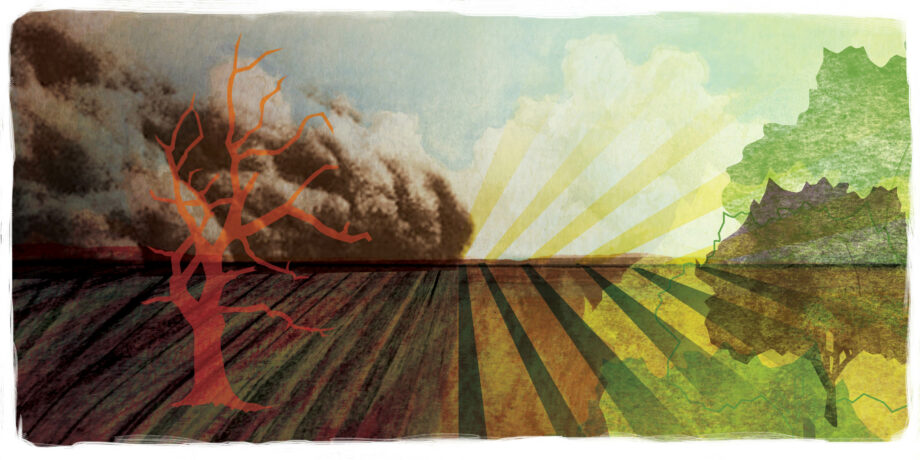January 7, 2013 — You know the quotation. “It was the best of times, it was the worst of times.” While Dickens was writing about the French Revolution and late 18th century Europe, these words seem particularly relevant in describing the state of the world today.
In fact, you might think modern society lives in two completely different worlds. One is hopeful, peaceful, exciting and moving toward a better future. The other is chaotic, unstable, unjust and inherently unsustainable. Strangely, both worlds seem to exist simultaneously, colliding in this moment in history.
The better world is one we’ve been building for millennia. It is the world that has risen out of humanity’s darkest moments, inspired by art, literature, science and spirituality. It is a world slowly moving beyond imperialism, conquest, ignorance, superstition, bigotry and disease — once norms of our civilization. And as Steven Pinker at Harvard has pointed out, it is a more peaceful than we have ever seen before. While slavery, genocide and war are not yet completely abolished, they are definitely moving towards the dustbin of history.
Unfortunately, a parallel chaotic, unsustainable world has been asserting itself as well. Born out of the Industrial Revolution, this world is hurtling toward catastrophic environmental damage and the mayhem it would wreak on civilization. You already know the issues: climatic disruptions, rising sea levels, acidifying oceans and massive societal dislocations; biodiversity losses, extinctions and collapsing ecosystems; declining water quality and supplies; and tattered ecosystems, invasive species and emerging diseases. It is a world pushing past planetary limits – skating on the edge, dangerously close to failure.
Whatever happens, make no mistake: This time, our time, is the one that will singularly define the world we will have for the next century, the next millennium, and beyond.
Both worlds are changing more rapidly now than at any other point in history. Pushed by science, technology, cultureand the cumulative progress of previous generations, innovation is building upon innovation, leading to exponential rates of change. In the past 50 years alone, world population has more than doubled, while economic activity grew sevenfold (adjusting for inflation), leading to massive increases in worldwide consumption of energy (4x), water (3x) and food (3x). The changes we have seen in the past 50 years have outpaced those of all previous human generations combined several times over.
But this exponential change has also given us amazing new tools and insights that can make us smarter, better connected and more adept at solving problems. In the past year alone, science has detected Earth-like planets elsewhere in the galaxy, and has discovered tantalizing clues about the “God particle,” perhaps the most fundamental building block of the universe. Following Moore’s law, our computers and phones roughly double in their capabilities every two years. New communication technologies now allow billions to learn, interact and organize, as evidenced by the Arab Spring and Occupy Wall Street. It is a wondrous time to be alive. There is promise in the air, if you only look for it.
Stepping back, it is clear that we are at an inflection point in human history. Changes in population, technology, economics and social movements are colliding with the limits of our planetary environment, and it is still far from clear how things will turn out. Will it be a disaster or a miracle? Or both? No one has a crystal ball, but we can be assured of one thing: The world of 2050 will be unimaginably different than the one we know today.
Whatever happens, make no mistake: This time, our time, is the one that will singularly define the world we will have for the next century, the next millennium, and beyond.
Whether we like it or not, this is our moment. We didn’t ask for it, but now we have to decide what to do with it. Will we simply be the people we tend to be — greedy, lazy and apathetic — or will we become the people we could be — brave, compassionate and working for a better world? Will we disappoint future generations, or will they look back on our time and be proud of what we accomplished? Which path will we choose: the world that is, or the world that can be?
In this issue of Ensia, we ask global thought leaders and innovators: What would it take to make a better world? What we found was both sobering and incredibly inspiring. Whether we consider the issues of climate change, environmental justice or preserving the world’s forests, there are people and ideas out there that point the way, showing us that a better world is possible — and within our grasp. The ideas are here. The hard part will be turning these ideas into action substantial enough to make a difference.
Robert Anton Wilson once challenged us by saying: “The future is up for grabs. It belongs to any and all who will take the risk and accept the responsibility of consciously creating the future they want.” Let us rise to that challenge, and create a future we want — a future our children and grandchildren deserve. ![]()
Editor’s note: The views expressed here are those of the author and not necessarily of Ensia. We present them to further discussion around important topics. We encourage you to respond with a comment below, following our commenting guidelines, which can be found here. In addition, you might consider submitting a Voices piece of your own. See Ensia’s “Contact” page for submission guidelines.
Ensia shares solutions-focused stories free of charge through our online magazine and partner media. That means audiences around the world have ready access to stories that can — and do — help them shape a better future. If you value our work, please show your support today.
Yes, I'll support Ensia!
